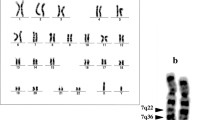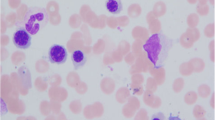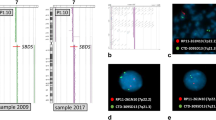Summary
We examined metaphases from three patients with chronic myeloid leukaemia and a typical Philadelphia chromosome with one chromosome 9 as the recipient to determine whether the 9q+ 22q- translocation is reciprocal. Good quality G-banded photographs of the chromosomes concerned were subjected to light absorption density analysis. This provided enlarged tracings corresponding to the relevant chromosome regions and so facilitated accurate measurement. This technique has unambiguously shown that the typical Philadelphia chromosome results from a reciprocal translocation and that probably no material is gained or lost in the exchange. Furthermore, in a total of six patients for whom sequential G and C banding was performed, the chromosome 9 with the largest block of centromeric heterochromatin received the translocated material. We offer tentative explanations for this curious observation.
Similar content being viewed by others
References
Buckton, K. E., O'Riordan, M. L.: Easy identification of chromosome translocation involved in chronic myeloid leukaemia. Lancet 1976 II, 1404
Caspersson, T., Gahrton, G., Zech, L.: Identification of the Philadelphia chromosome as a number 22 by quinacrine mustard fluorescence analysis. Exp. Cell Res. 63, 238–240 (1970)
Chapelle, A. de la, Schröder, J.: Apparently non-reciprocal balanced human (3q-;Xq+) translocation, late replication of structurally normal X. Chromosomes Today 4, 261–265 (1974)
Gahrton, G., Lindsten, J., Zech, L.: Clonal origin of the Philadelphia chromosome from either the paternal or maternal chromosome number 22. Blood 43, 837–840 (1974)
Gahrton, G., Friberg, K., Zech, L.: A new translocation involving three chromosomes in chronic myelocytic leukemia, 46,XY,t(9;11;22). Cytogenet. Cell Genet. 18, 75–81 (1977)
Goodpasture, C., Bloom, S. E., Hsu, T. C., Arrighi, F. E.: Human nucleolus organizers: The satellites or the stalks? Am. J. Hum. Genet. 28, 559–566 (1976)
Ferguson-Smith, M. A., Page, B. M.: Pachytene analysis in a human reciprocal (10;11) translocation. J. Med. Genet. 10, 282–287 (1973)
Francke, U.: Quinacrine mustard fluorescence of human chromosomes: Characterization of unusual translocations. Am. J. Hum. Genet. 24, 189–213 (1972)
Hansmann, I., Wiedeking, C., Grimm, T., Gebauer, J.: Reciprocal or nonreciprocal human chromosome translocations? Hum. Genet. 38, 1–5 (1977)
Mitelman, F., Levan, G.: Clustering of aberrations to specific chromosomes in human neoplasms. II. A survey of 287 neoplasms. Hereditas 82, 167–174 (1976)
Nowell, P. C., Hungerford, D. A.: A minute chromosome in human granulocytic leukemia. Science 132, 1497 (1960)
Page, B. M.: Identification of chromosome 9 in human male meiosis. Cytogenet. Cell Genet. 12, 254–263 (1973)
Rowley, J. D.: A new consistent chromosomal abnormality in chronic myelogenous leukaemia identified by quinacrine and giemsa staining. Nature 243, 290–293 (1973)
Schmid, M., Vogel, W., Krone, W.: Attraction between centric heterochromatin of human chromosomes. Cytogenet. Cell Genet. 15, 66–80 (1975)
Shaw, M. W.: Annotation: Human chromosome abnormalities revisited. Am. J. Hum. Genet. 24, 227–228 (1972)
Stephen, G. S.: Mammalian chromosomes G-banded in four minutes. Genetica 47, 115–116 (1977)
Sumner, A. T.: A simple method for demonstrating centromeric heterochromatin. Exp. Cell Res. 75, 304–306 (1972)
Unnérus, V., Fellman, J., Chapelle, A. de la: The length of the human Y chromosome. Cytogenetics 6, 213–227 (1967)
Watt, J. L., Hamilton, P. J., Page, B. M.: Variation in the Philadelphia chromosome. Hum. Genet. 37, 141–148 (1977)
Author information
Authors and Affiliations
Rights and permissions
About this article
Cite this article
Watt, J.L., Page, B.M. Reciprocal translocation and the Philadelphia chromosome. Hum Genet 42, 163–170 (1978). https://doi.org/10.1007/BF00283636
Received:
Issue Date:
DOI: https://doi.org/10.1007/BF00283636




